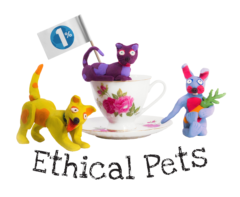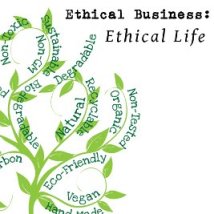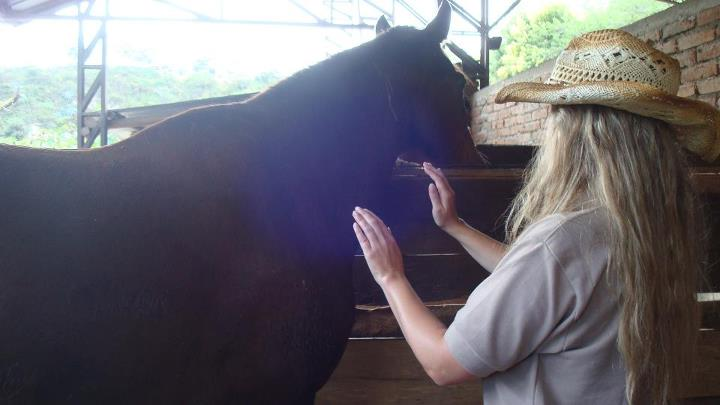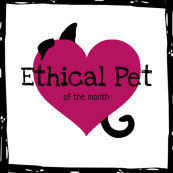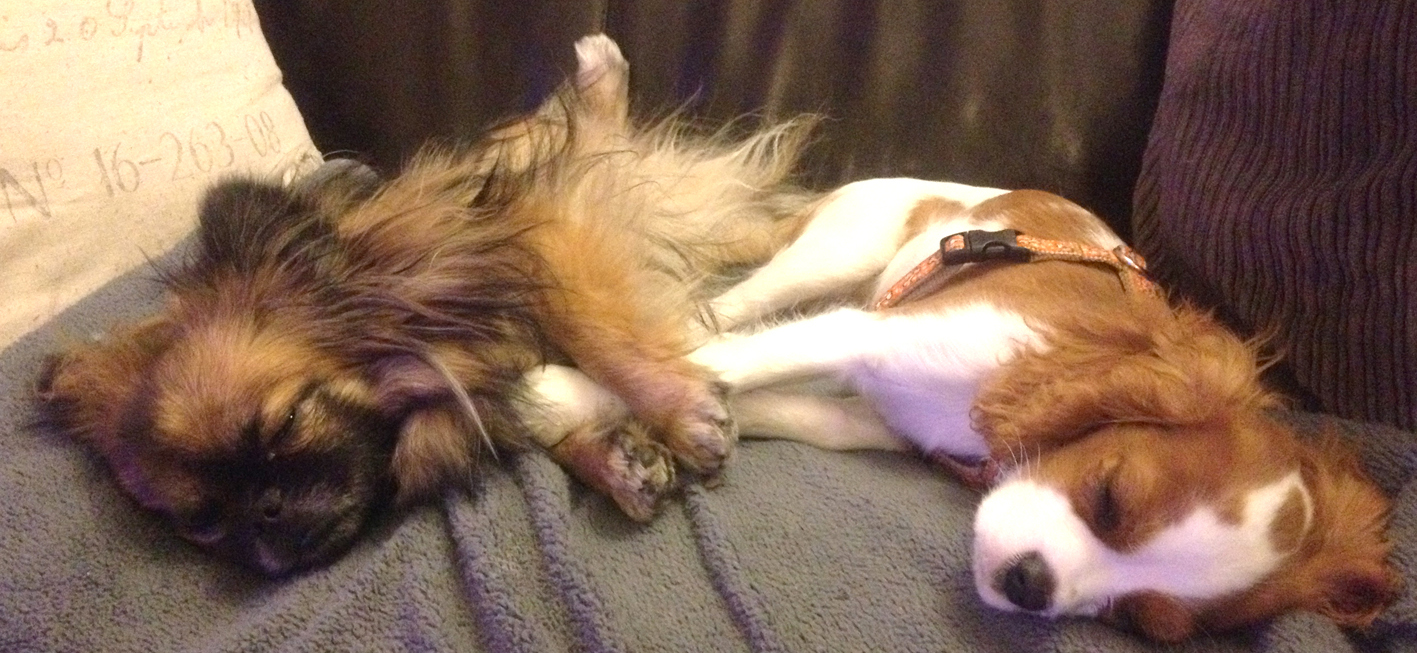When did you have the idea to set up your Vegan shoe shop?
I started Wills with a passion to provide animal and human friendly shoes with high-street styles and prices. My dream is to bridge the gap between everyday people and ethically produced vegan shoes.
Continue reading “Ethical Buisness: Ethical Life. Vol 6.”
Category: Guest Blogs
Polythene Pam Loves BecoBowls!
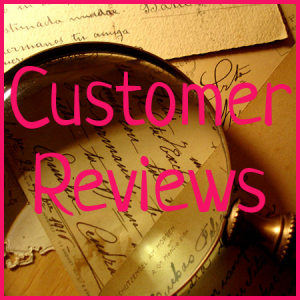 It’s not that we are attention seekers… but we do love it when people talk about us! Here is a fab little article about us published recently by the Plastic Is Rubbish team Polythene Pam and Village Boy. They just LOVE our super-sustainable plastic free pet bowls from BecoThings… did you hear they are made from rice husks and bamboo? Now that’s the kind of gossip we like to see spreading! Take a read of what they said below:
It’s not that we are attention seekers… but we do love it when people talk about us! Here is a fab little article about us published recently by the Plastic Is Rubbish team Polythene Pam and Village Boy. They just LOVE our super-sustainable plastic free pet bowls from BecoThings… did you hear they are made from rice husks and bamboo? Now that’s the kind of gossip we like to see spreading! Take a read of what they said below:
Bike North Birmingham and Bike Everyone – what they do.
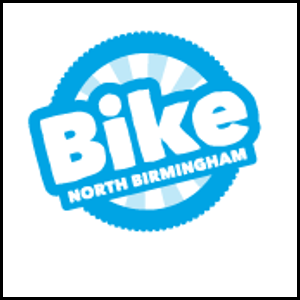 Joey and I are keen to start cycling, and we think this Project in Birmingham is really great! They have so much to offer so its well worth a look if you live locally (Anna’s Grandma lives in Erdington by the way, another reason we love this project so much). In putting together our cycle themed newsletter we have learned loads about how green cycling is, how useful bikes are and the cool stuff can be done with your bike when its old. All in all, we are pretty impressed with bikes! This is What Bike North Birmingham had to say:
Joey and I are keen to start cycling, and we think this Project in Birmingham is really great! They have so much to offer so its well worth a look if you live locally (Anna’s Grandma lives in Erdington by the way, another reason we love this project so much). In putting together our cycle themed newsletter we have learned loads about how green cycling is, how useful bikes are and the cool stuff can be done with your bike when its old. All in all, we are pretty impressed with bikes! This is What Bike North Birmingham had to say:
NB: THIS PROJECT HAS NOW ENDED
Bike Everyone is part of the Bike North Birmingham project and we are making it easy for residents of Erdington and Sutton Coldfield Constituencies to get on their bikes! With cycle routes in and around the area and with more to come – our aim is to make cycling more accessible for the ‘may be’ cyclist’, whether it’s cycling to work, to the shops or purely for pleasure and fitness.
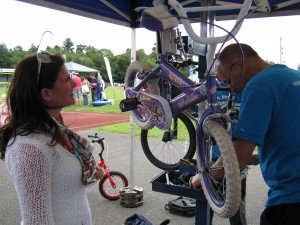 Bike North Birmingham was launched in April 2012 and in its first year up to December 2012, and despite the poor weather, we managed to attract over 350 adults and families on to our leisure rides. Over 112 adults took part in the Learn to Ride Programme over 100 bikes have been loaned out for up to 6 months giving people the opportunity to really think about buying a bike for good. The short term hire bikes have been loaned out over 250 times and many people have reported that thanks to the project their travel habits are changing and they feel they are becoming fitter as a result.
Bike North Birmingham was launched in April 2012 and in its first year up to December 2012, and despite the poor weather, we managed to attract over 350 adults and families on to our leisure rides. Over 112 adults took part in the Learn to Ride Programme over 100 bikes have been loaned out for up to 6 months giving people the opportunity to really think about buying a bike for good. The short term hire bikes have been loaned out over 250 times and many people have reported that thanks to the project their travel habits are changing and they feel they are becoming fitter as a result.
To help people discover the joys of cycling, we offer:
FREE bike hire:
For individuals, friends and families, borrow a bike for the day and get out and explore some of the parks and cycle routes in the North of Birmingham. Bikes are available from our two new cycling hubs at Erdington and Wyndley Leisure Centres.
FREE long term loan of bikes:
Need a bike to get to work or help cut the cost of getting around? Thinking about buying a bike but not sure? Borrow one of ours for a few months to help you decide!
FREE cycle training:
If you’ve never ridden a bike before or haven’t cycled for a while, or maybe you just need a confidence boost, book some sessions with us!
FREE Commuter training:
Do you want to be more confident on the road and perhaps cycle to and from work, we can help with 1 -1 training!
FREE Leisure Rides:
and other cycle activities
Fun group rides with qualified Ride Leaders for cyclists of
all abilities
FREE Cycle maintenance classes:
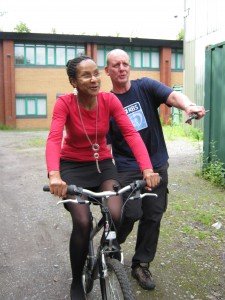 Learn some basic maintenance to keep your bike in a good condition
Learn some basic maintenance to keep your bike in a good condition
Some up and coming activities for you to join in with in the next couple of months are:
Easy Riders Cycling Group – a Wheelie Friendly way to cycle!
Weekly on Wednesdays at 10am
Normal Starting Point: Brookvale Park
Level: Gentle – Moderate
Cycling around and about from the tranquil Brookvale Park and other locations. Why not come along to enjoy a sociable and satisfying morning bike ride?
Health and Fitness Rides
Weekly on Thursdays at 10am
Starting Point: Brookvale Park
Level: Gentle – Leisurely
Do you want to Lose Weight? Stop Smoking? Get Fit? Cycling can help! So why not get on a bike and ride towards a healthier lifestyle? Feel great about yourself!
Aston Hall for Tea
Sunday 16th June 2013 at 11:30am – 1:30pm
Starting Point: Brookvale Park by the Sailing Club, B23 7SL
Level: Leisurely/ Moderate
Cycle back in time to 17th Century surroundings; feel refreshed from time in the tea rooms and a wander around the idyllic gardens and grounds. 10% discount in tea rooms!
Find The Fort by Bike
Starting Point: Erdington Leisure Centre [Pool], B24 9EJ
Fri 14th June at 12pm – 1pm and Sunday 7th July at 10am – 11am
Level: Leisurely/Moderate
Find out how quick and easy it is to get to The Fort Shopping Park from Erdington by bike!
Lots more rides on www.bikenorthbirmingham.org.uk (website has now changed hands) – don’t forget to book by calling us on 464 1020
FREE Basic Cycle Maintenance courses and workshops
Our five session courses will introduce you to basic cycle maintenance in a relaxed and supportive environment. You don’t need any experience, just the desire to get hands on and skilled up!
Courses cover: Puncture repairs, replacing inner 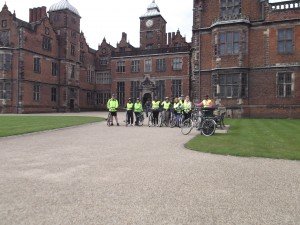 tubes, headsets, handlebars and stems, set up and adjustment of brakes and gears and how to index them too.
tubes, headsets, handlebars and stems, set up and adjustment of brakes and gears and how to index them too.
Tuesdays 7pm – 8.30pm
4th ,11th,18th,25th June, 2nd July at Kingsbury School and Sports College, B24 8RE
Wednesdays 7pm – 8.30pm
5th , 12th. 19th, 26thJune, 3rd July
Clifton Road Youth and Community Centre, B73 6EB
To book any of our activities call 0121 464 1020
Activities open to Leisure Card holders residing in Erdington and Sutton Coldfield Constituencies.
Continue reading “Bike North Birmingham and Bike Everyone – what they do.”
Marie Dunnion on Animal Healing
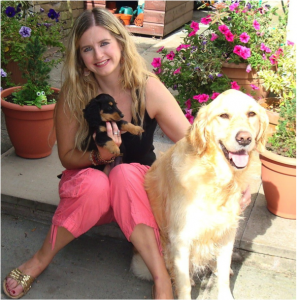 Meet Marie. With a degree was in English literature, followed by a Graduate Diploma in Psychology, and an MSc in Work Psychology and Business, on paper, she sounds rather straight laced at first… and of course she is very academic and clever. However, the is much more to Marie than meets the eye – as she is also an animal healer. We met her at the Kings Heath Cruelty Free X-mas fair in 2011, where she was manning the Animal Freedom charity stall. Since then we have kept in touch and really enjoy her positive personality and inspiring lifestyle. Here’s an article she wrote for us
Meet Marie. With a degree was in English literature, followed by a Graduate Diploma in Psychology, and an MSc in Work Psychology and Business, on paper, she sounds rather straight laced at first… and of course she is very academic and clever. However, the is much more to Marie than meets the eye – as she is also an animal healer. We met her at the Kings Heath Cruelty Free X-mas fair in 2011, where she was manning the Animal Freedom charity stall. Since then we have kept in touch and really enjoy her positive personality and inspiring lifestyle. Here’s an article she wrote for us
I feel incredibly honoured that Ethical Pets have invited me to contribute a guest blog and I hope that sharing my story as an Animal Healer will inspire you to welcome more healing energy into your own lives and that of your animal companions. Although not a blog about veganism, I believe it is important to explain the connection between my veganism and my animal healing practice.
Before training as a healer, I was neither vegetarian nor vegan, but as I progressed on my spiritual journey, my heart expanded with love for animals and I eliminated meat from my diet. Once I started studying towards a Diploma in Animal Healing, I felt increasingly uncomfortable about the contradiction between eating animal-based products whilst also healing animals. In psychology, this state of mind is called cognitive dissonance. Again, my love for animals prompted another change in diet and I became vegan.
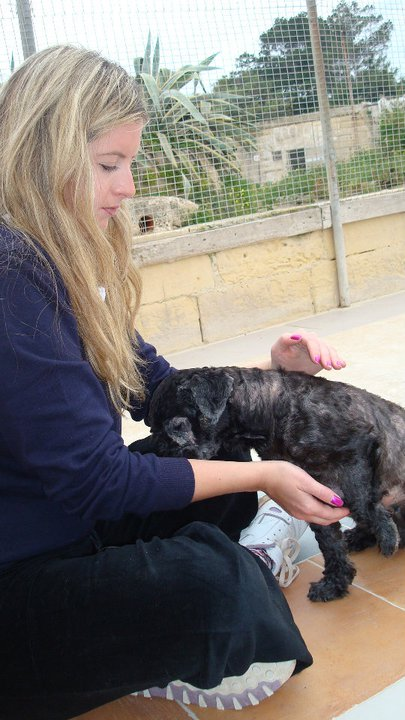
Veganism is my way of showing love for animals. After all, what is more healing than to ensure that I in no way contribute to the suffering of any other sentient being? I have a great affinity with Buddhism and it’s teaching that we should try never to harm any living being. Perhaps not every Animal Healer will subscribe to this belief system, but this is my story and I can only share with you the experiences of my own heart. Please take from it what you will, and use it to infuse your soul with some animal magic!
What is Animal Healing?
Animal healing is a simple but effective way of radiating loving energy to an animal for their highest good. All animals, great or small, can benefit from healing and this works on many different levels – physical, emotional, spiritual, and psychological. During a healing session, I channel healing energies through my hands to the animal, usually maintaining a slight distance between my hands and the animal’s body. Direct hands-on healing may sometimes be appropriate but this will depend on the animal, and personal safety is always a priority.
Another vital ingredient for animal healing is intention. As an Animal Healer, I work from the heart, setting an intention of love which I then channel to the animal. I silently ask for the animal to receive healing, but I then try to detach myself from the outcome of this request. This might sound strange, but I have learnt that it is better to “let go” and just trust that the animal will absorb the healing where it is needed.
When I explain healing to an animal’s guardian, I tell them that it helps the animal to enter into a state of relaxation. The more relaxed an animal is, the better able they are to draw on their own natural resources to deal with illness or injury. It is important to note that animal healing is a complementary therapy. If an animal is ill, veterinary attention should be immediately sought and the vet’s permission asked in relation to complementary therapies.
Healing is not just about touch – it involves all of the senses. For instance, I will usually put on some calming music for a healing session, and this certainly contributes to the animal’s state of relaxation. I even play an animal sound therapy CD to my neighbourhood ducks through the kitchen window. This video shows the amazing results of this sound healing!
Sound Healing with Wild Ducks
The ducks in this video are relaxing to Elizabeth Whiter & Tim Wheater’s Animals Whispers Sound Therapy CD. This unique piece of healing music was recorded with 528 Hz, the frequency of love, and the precise scientific vibration of nature and life itself. You can find out more about this healing music CD at: https://www.healinganimals.org/pg-animal_whispers.html
Equine Healing
I am also a registered Equine Healer, and although this involves me working in much the same way as I would with animal healing, it involves a slightly different approach because horses are much bigger animals than most and they are known for their sensitive natures. This means that healing a horse can quite often feel like an intensely spiritual experience for the Equine Healer. The day after one equine healing session, I ran into a colleague in the corridor and she complimented me by saying, “You seem very calm!” I am sure she was picking up on the equine energies which I was still carrying with me from the day before!
Equine eyes are so very soulful and, despite their size, horses usually have a very gentle energy. Last year, I did equine healing with a beautiful pony called Peter and the following feedback from Peter’s guardian helps to illustrate how equine healing works in action:
“Marie came out to my pony, Peter, who had just moved yards and I thought the session would help him relax and settle into his new loan home. I was very impressed by the effect the treatment had on Peter, he really relaxed and responded to the treatment during the session. Marie was very calm around Peter who seemed to be very happy with her presence. She constantly advised me what she was doing, why she was doing it and what Peter’s responses meant, which I found useful and interesting so that I was able to understand the process of the treatment” – Rebecca Crowther, Halesowen, West Midlands (21 January 2013).
My animal healing has taken me all over the world and I would like to share with you a very special photo of an equine healing session which took place at Fundación AM-EN in Ecuador – in this picture a circle of healing light is clearly visible around my hands!
Bebeto, the rescue horse pictured, was receiving healing specifically for an inflamed hoof. However, the likelihood is that he would have taken in the healing on many other levels as well. You will see a white mark around his neck, an unfortunate reminder of how he was found tied up, starving, and near death. After my return home, Heidi Paliz, the President of Fundación AM-EN, contacted me to say thank you – Bebeto was healthy and well again! In fact, Heidi was so impressed with the positive effects of equine healing on her horses that she still gets in touch to request distant healing for other equine patients. The great thing about animal healing is that it also travels across the miles!
Crystal Therapy for Animals
My account of animal healing would not be complete without a mention of Crystal Therapy for Animals. Crystals work through resonance and vibration, helping to rebalance the animal’s energy field through the healing energy they emit.
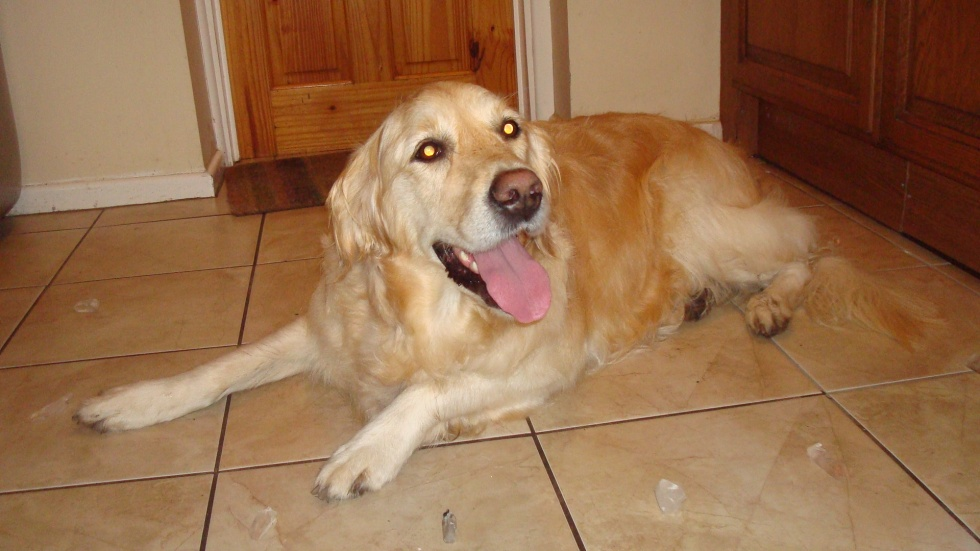
Crystals are a special passion of mine and, although I have been a Crystal Therapist for many years, it was with great joy that I recently completed the UK’s first ever training course in Crystal Therapy for Animals at The Animal Magic School of Animal Therapy. This qualification has already proved valuable beyond measure, and I would like to share with you the story of Rosie the cat, as told by her guardian, Julie:
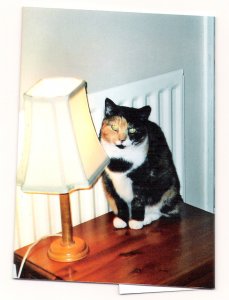 “Marie came a few weeks before Christmas to help our cat, Rosie, who has thyroid problems, asthma and, most recently, the vet discovered she has tumours which, because of the proximity to her aorta, can’t be analysed or removed…After going through Rosie’s medical history, Marie used crystals for the healing and the atmosphere was very calm and relaxing for both myself and Rosie, who sat quite still for about 20 minutes while the healing took place. It was a very warm, calm, relaxing and lovely experience…Marie has continued to do distance healing for her…I am sure this is helping her because she is still very calm and not at all distressed by her illnesses. She is continuing with her medication prescribed by the vet but I am sure she is holding her own because of the healing. Much to the vet’s amazement, she has a healthy appetite and is still her old self. We know that at some point we will have to let her go, but at the moment she is still enjoying her life and all the attention she’s getting” – Julie Perry, Stourbridge, West Midlands (20 January 2013).
“Marie came a few weeks before Christmas to help our cat, Rosie, who has thyroid problems, asthma and, most recently, the vet discovered she has tumours which, because of the proximity to her aorta, can’t be analysed or removed…After going through Rosie’s medical history, Marie used crystals for the healing and the atmosphere was very calm and relaxing for both myself and Rosie, who sat quite still for about 20 minutes while the healing took place. It was a very warm, calm, relaxing and lovely experience…Marie has continued to do distance healing for her…I am sure this is helping her because she is still very calm and not at all distressed by her illnesses. She is continuing with her medication prescribed by the vet but I am sure she is holding her own because of the healing. Much to the vet’s amazement, she has a healthy appetite and is still her old self. We know that at some point we will have to let her go, but at the moment she is still enjoying her life and all the attention she’s getting” – Julie Perry, Stourbridge, West Midlands (20 January 2013).
Rosie sadly passed over to Rainbow Bridge last month, but the healing she received possibly gave her a better quality of life in those last few precious months with Julie. I would like to dedicate this blog to Rosie and thank Julie for allowing me to share Rosie’s story.
I would also like to thank all of you for taking the time to read this blog and I hope that it has sparkled some fairy dust onto your day. Please get in touch if you would like to know any more about animal healing! If you are interested in booking an animal healing session, these are available in the Norwich area or via Skype for those further afield.
Love & Blessings,
Marie Dunnion – BA (Hons), DipPsych, MSc, MBPsS
Animal Healer, Member of the Healing Animals Organisation (MHAO)
E-mail: marie@emeraldcityhealing.co.uk
Website: www.emeraldcityhealing.co.uk
Facebook: facebook.com/emeraldcityhealing
Want to read more articles like this? Sign up to our newsletter!
Hope and Freedom – Two amazing Dogs Trust projects.
Dogs Trust, the UK’s largest dog welfare charity, has been helping homeless and vulnerable dog owners for almost 20 years through its Hope and Freedom Projects.
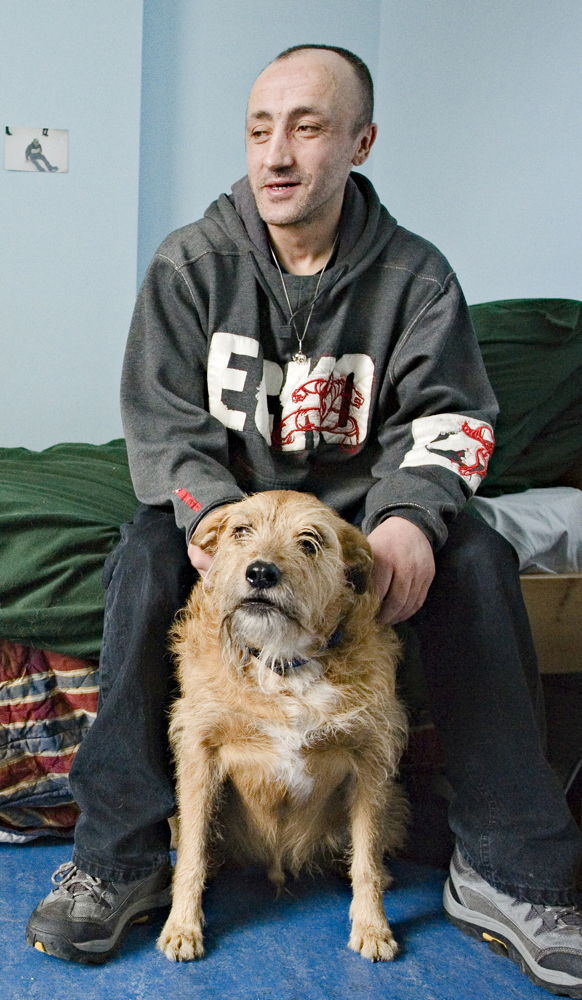
The Hope Project
The Dogs Trust Hope Project helps dogs whose owners are homeless or in housing crisis by providing advice, support and veterinary assistance for their dogs.
The Hope Project Veterinary Scheme offers free and subsidised veterinary care to any dog owner who is rough sleeping or living in temporary accommodation. The scheme runs in 100 towns and cities across England, Northern Ireland, Scotland and Wales and offers free preventative healthcare – microchipping, neutering, vaccinations and flea and worming treatments. Dogs Trust can also subsidise most other essential veterinary treatments that a dog would need. Since the scheme began in 2004, the Hope Project has funded more than 10,000 veterinary treatments.
The Dogs Trust Hope Project also works with providers of homelessness accommodation to encourage them to accept residents with dogs. Unfortunately most homelessness organisations and housing providers in the UK still do not accept clients with dogs. Currently only 7% of hostels are dog-friendly [1]. This means that many people are being denied access to shelter and support, simply because they have a dog. Dogs Trust offers advice to accommodation providers on a range of issues such as introducing a pet policy, health and safety, hygiene and behaviour.
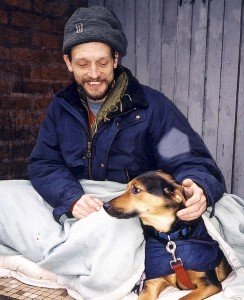
Every Christmas, Dogs Trust works with winter shelters and homelessness projects to provide a Christmas parcel service. Christmas can be an especially difficult and lonely time for people who are homeless. By sending out parcels of treats, toys, coats, collars and leads, the Hope Project tries to make Christmas special for homeless people and their dogs as well as providing essential coats and jumpers to keep the dogs warm during winter.
The Freedom Project
The Dogs Trust Freedom Project is a pet fostering service for dogs belonging to families fleeing from domestic violence.
Each year, thousands of women suffer abuse at the hands of their partner. Research indicates a strong link between animal abuse and domestic violence, with men who are violent to women often threatening or harming a pet in order to intimidate their partner.
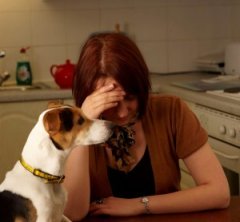
Families fleeing domestic violence are usually unable to take their pets with them into a refuge or temporary accommodation, so in many cases they are reluctant to leave their home until they know there is somewhere safe for their pets.
Dogs Trust offers a service which places dogs in the homes of volunteer foster carers until their owners are in a position to take them back. Dogs Trust covers all expenses so there are no costs for the volunteer foster carer or dog owner. The service operates in Greater London, Hertfordshire and Yorkshire. In Greater London & Hertfordshire, Dogs Trust can also foster cats in partnership with Cats Protection. Since it began in 2004, the Freedom Project has fostered more than 1000 pets.
[1] Homeless UK, Homeless Link.
For more information on Dogs Trust’s Hope and Freedom Projects, please visit www.moretodogstrust.org.uk
 Dogs Trust is funded solely by public generosity. If you would like to make a donation towards the work of the Dogs Trust Hope Project or the Dogs Trust Freedom Project, please go to www.moretodogstrust.org.uk/donate.
Dogs Trust is funded solely by public generosity. If you would like to make a donation towards the work of the Dogs Trust Hope Project or the Dogs Trust Freedom Project, please go to www.moretodogstrust.org.uk/donate.
Want to read more articles like this? Sign up to our newsletter!
Missi Hathaway on Ethical Pet Insurance
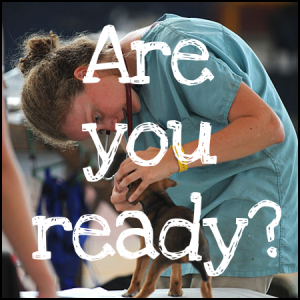 The Importance of Insuring Your Pet
The Importance of Insuring Your Pet
Our pets are part of the family, which is why we should go to great lengths to look after them. If they sadly become ill or have an accident, it is our responsibility to get them the right care. Unfortunately, the cost of taking animals to the vet can be high which is why having the right pet insurance in place can protect owners and the animal. We may not like to think of our animals becoming unwell or getting knocked down on a main road, but if the worst happens, it’s best to be prepared with a comprehensive pet policy. It’s not just illnesses or accidents which require a trip to the local vet either. When we first get our new addition to the family, we need to make sure of a number of things. Depending on the kind of pet you have, you may need to inoculate them from any infections that can be picked up. Kittens for example need a series of injections before they can go outside. You may also want to have them micro chipped. Animals prone to running away or getting stolen can be identified by a chip that brings up the owner’s details when scanned. Neutering or spaying your pet will also prevent any unwanted breeding occurring and can also reduce the cost of a pet insurance policy, albeit marginally.
Getting Insurance For Your Animal
There are different ways to go about insuring pets. You have to look at what is cost effective for you and the kind of animal you own. The most popular pets in Britain are dogs and cats, followed by rabbits. All pets however need to be considered when it comes to those hefty vets bills. Some will require more specialist insurance, such as horses and ponies. You need to check you are covered for public liability insurance, accident cover and if appropriate, horse boxes. Looking at the small print is vital, rather than just going with the cheapest provider. Check your pet is covered for: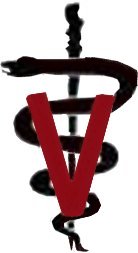
* Type or breed of animal
* Travel
* Age of the animal
* More than one pet
* Kennel or cattery fees
* Death
*Accidental damage
You will also need to get the right policy. If you will need long term care for a pet with medical problems, you’ll need a high level cover.
Ethical Pet Insurance
You may feel that investing in your pet is costly, but it is best to be prepared if the worst happens. If you don’t have money put aside, insurance will protect your purse and your pooch. Going with an ethical provider can mean a percentage of the net profit goes to animal charities so you can be involved with helping out other animals in need. When looking for ethical insurance, you can take into consideration how much it will cost you to insure your pet, and how much is donated to charity. For example, the Animal Friends insurance group have so far donated over one million pounds of their profits to welfare charities in the UK and worldwide. They also offer good value insurance.
There are many ethical providers of pet insurance. Some are considered to be eco-friendly as they donate some of the profits they make to help endangered species. Some also contribute to conservation organisations which help to conserve natural habitats for wild animals. These include wetland and wildlife areas as well as protecting plant life. Some of the insurance organisations donate their profits to various animal welfare charities both nationally and internationally. The Co-Operative bank have declined finance from businesses who do not meet animal welfare standards. They will not promote animal testing, blood sports, the fur trade or exploitation of great apes. This means only accepting finance from companies who are not involved in these trades. They are also against intensive farming, which involves farming caged animals.
When deciding on an ethical insurance company, you may consider which to go with on a number of factors. This may depend on which charities the profits are donated to, how eco-friendly they are or which ones contribute to climate change. Some may be clearer on their investments than other companies, so you will know where the money goes.
Also, the cost of the insurance and excess and getting the right kind of insurance for your particular pet is important.
Alternative Ways to Afford the Vet
Saving enough money to put aside for emergencies can have it’s advantages and disadvantages. Using an easy access savings account can help when you need some cash for your poorly pet. The downside would be that you would have to have enough money in your fund in case you need it. If your pet needed an unexpected visit to the vet, you will need some funds to hand.
However, you may to decide not to ensure your pet. The advantage would be if your pet stays well, and you’ve saved money you would have otherwise spent on insurance.
It is a good idea to get a good deal for your savings account, or if you need a low interest loan to use for vets bills. There are ethical ways to save money with mutual savings banks. They are set up by depositors and borrowers, and all the profit is reinvested in itself. Also known as credit unions, joining the scheme is an alternative.
The credit unions are non profit organisations and so you can put away as much as you like into your savings account. The credit unions pay a yearly dividend, meaning you get money back at the end of it on a percentage of what you saved. If you use this as an alternative to pet insurance rather than putting money into insurance, you are also saving. So, if your pet doesn’t require a visit to the vet that year, you have your savings and any extras on top. It could come in handy if anything happened to your beloved companion.
_____
Missi writes on behalf of one of the UK’s largest consumer advice and information portals. She specialises in pet health and insurance topics. She grew up in Southampton, PA but is spending most of 2013 in Manchester, England where she has family.
Ethical Buisness: Ethical Life. Vol 3.
Welcome t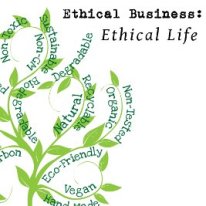 o Ethical Business: Ethical Life – we aim to showcase the people behind the amazing Ethical Businesses we meet through running Ethical Pets.This third edition is about Tanya Vaughan, an interior designer from Lincolnshire. We met Tanya only a few weeks ago, when she bought one of our Eco Donut beds for her dog Wrighty – we got to chatting and well… as you can see, she is pretty inspiring!
o Ethical Business: Ethical Life – we aim to showcase the people behind the amazing Ethical Businesses we meet through running Ethical Pets.This third edition is about Tanya Vaughan, an interior designer from Lincolnshire. We met Tanya only a few weeks ago, when she bought one of our Eco Donut beds for her dog Wrighty – we got to chatting and well… as you can see, she is pretty inspiring!
When did you start your ethical business, what are your ethical principles and how do they guide and motivate you?
I hadn’t set out specifically to start an ethical business, or indeed a business at all! I had been decorating and designing houses for years without stopping to think about it, from digging my own drainage trenches (never again…) to shipping a huge pair of doors back from Morocco, to mount on a wall. It took a long time to twig that I should transform this passion into a business.

The idea was easy enough, having run my own market research business for a number of years, and the only challenge was my confidence – essentially putting myself on the line. What if no-one likes my ideas? The answer to that, in my business, is very easy – they just won’t hire you. The ones who do like it, will. A nerve-wracking realization.
For me, running my business ethically has just been a natural integration of what I do at home, and taking that into the workplace. From printing as little as possible, to choosing FSC certified paper for my letterhead or paying a little bit extra for green energy, the way I do everyday tasks translate very well from home to business. My studio is a couple of minutes walk from home, and I live in Stamford, which is a bustling and cosmopolitan market town with a wealth of independent shops, and small businesses to serve me, all within walking distance.
In re-designing a house, a room, considering knocking an existing building down and starting again, you begin to take notice of how much can get discarded, whether it’s an old chair, a cheap sofa that was bought as a stop-gap, or the bricks & mortar of a 1950s bungalow making way for a sleek and contemporary family home. You certainly notice new things. Some of them are utterly gorgeous. Clients want them. So in an arena where the acquisition of things seemingly plays such key role, I ask myself all the time, how can I make this sustainable?
So, how do you make designs sustainable?
Fundamentally, I support good design. Good design means a lot of things. What it doesn’t mean to me is spending money for it’s own sake, to brag, show-off, or provide fleeting excitement and interest only to be discarded when the next thing comes along. There are products designed specifically to attract these people. I am not interested, and I won’t recommend them to clients. I am also unlikely to be dealing with that kind of client! I am constantly on the lookout for vintage and antique pieces, re-using what already exists in the world, sometimes with an update, sometimes used in a different way to which it was intended. When looking at anything new, I am interested in products that are designed with a lot of thought, that are made by people who are paid a fair wage for what they do. I look for products that are designed with longevity in mind, so that they will be kept for a very long time – even if that means being sold or given to someone else. Because if they are not, they only end up in one place – landfill.
The most important thing about the fabric of any building is how it stores and uses energy. So regardless of whether it’s made of timber, concrete, steel, or glass, how that structure retains heat, or keeps out heat, is key. This is one of the most sustainable aspects of building, and taken in it’s wider sense, can mean things like putting in large glass panels with specifications that far exceed the regulations, which not only keep the heat in, but positioned correctly, can let more sunlight in in the winter to help heat the room inside. Making it nice and toasty inside is one thing, given the right design and materials, a sustainable building is one that is going to serve it’s purpose for a very long time to come, contributing positively to the lives of the people who use it.
Describe an average day in the life of you.
I generally get up any time from 6, as I have so much to do. It’s a luxury to sit with a cup of tea in PJs answering emails or checking information on-line and watching the sun come up, particularly if I am staying in Norfolk to oversee the project that is taking up most of my time at the moment, where a blue jay and a woodpecker shout loudly on the trees outside the kitchen window.
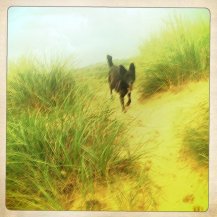
I can be working on plans, whether its working out wall thicknesses for bespoke door frames, or drawing elevations, or I can be chasing sub-contractors, checking quotes, placing orders, or sourcing lighting or furniture. Site visits involve warm clothes, a tape measure and a sense of humor – there is always something to throw a spanner in the works! If something really hasn’t gone to plan, then a blast on the beach with the mutt usually de-stresses me and I can come back with a clear head to think through a creative solution. Having a project in such lovely countryside is a fundamental part of how I want the business to continue – being able to stay here for several days a week to project manage is such a treat. When the sun hits the sand dunes and the salt marsh, with the grasses rustling and the colors all greys and greens, I have no desire to jet away to remote shores.
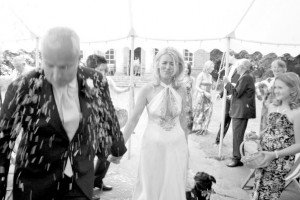
I regularly get out and about searching for stuff – fabric, furniture, light fittings, and often find myself at antiques fairs, or dealers’ showrooms to view something in particular that might work for a specific room. I always love getting something old into a scheme, and love being part of the decorative industry that finds value in these beautifully crafted objects with all of their history and patina of age. Sometimes this means working with a designer-maker directly, for example here in Norfolk I have found wonderful craftspeople making wall hangings, a pottery that makes ceramic pendant lights, even the builders, who might not have built a wall with that finish before, but working together we make it happen and we haven’t had to either compromise on the design, or ship in some expensive and unnecessary expertise or product from elsewhere – my first stop is always local craftsmen and tradespeople.
Any words of wisdom?
Put your flag in the ground, stand tall and be passionate about your business. In the words of Aung San Suu Kyi “If you have chosen a certain path ..walk it with satisfaction and with determination and try not to make it appear as a tremendous sacrifice…Whatever you do out of your own free will, that should be a gift that you give to life or to those whom you love”
All links below were broken so have been removed
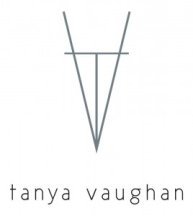 Tanya’s website is having a little makeover at the moment, but check out her Facebook and Twitter to see more of her amazing designs and wonderful, ethical, life. Here is what Tanya had to say about Ethical Pets:
Tanya’s website is having a little makeover at the moment, but check out her Facebook and Twitter to see more of her amazing designs and wonderful, ethical, life. Here is what Tanya had to say about Ethical Pets:
“I just wanted to say how impressed I am by your ethical policy statement. Most ethical policies I have read seem a bit vague.. yours is so comprehensive regarding all aspects of your business and personal lives. I will be forwarding your website address to many friends I know who will be really interested!”
Pet Food: Why Organic?
What does “organic” mean in relation to pet food?
Animal Welfare: For Yarrah as an organic pet food company, the most important aspect of organic agriculture is the very high regard for animal welfare. Poultry, cattle and fish form the basis of our premium Nature’s Finest pet food. It is therefore crucial that these animals are treated with dignity and respect. Organic agriculture guarantees that poultry and cattle have room to move and grow at a natural rate in an environment that minimizes stress. Because regulation regarding organic fish do not meet our standards of animal welfare, Yarrah has decided to switch to MSC-fish (read our statement!).
Nothing artificial: Yarrah does not add any chemical colorings, aromatic substances or flavorings. We do not use artificial preservatives: we preserve our dry food with vitamin E and rosemary extracts. For our wet food we use precise temperatures for sterilization. These steps ensure that the valuable vitamins and minerals are not broken down during production.
Our natural and organic recipes contain all the required vitamins, minerals, proteins and amino acids a dog or cat requires in the correct proportions. All of our products are made from certified organic materials in compliance with EU Regulations for Organic Products. The Dutch organic hallmark (EKO) issued by Skal is the guarantee for the organic origin and manufacture of the products.
All certified organic ingredients are completely traceable to the source. All the organic materials are constantly monitored from start to finish ensuring they meet our stringent requirements. To be sure all the ingredients are 100% organic, Yarrah buys all the ingredients themselves. To give this 100% guarantee the Quality manager of Yarrah visits the producers personally; the larger ones at least once a year, the smaller once at least every other year.
No animal testing: Yarrah deliberately rejects any and all animal testing. Any palatability tests (to gauge the pets acceptance of the product) are carried out in the pets natural home setting. Yarrah does not allow any of our foods to be tested using either captive animals or invasive testing techniques. This has some consequences for our health claims. We cannot claim that our products have beneficial influences for your pet. Luckily there are many people who are very happy with our products and are willing to tell this to others.
Alternative testing: How do we test our products? Simple: if we want to introduce a new flavour or a new product, we ask about 100 dog or cat owners to feed the new product to their pet. Of course none of the ingredients has a health risk, so it is absolutely safe for the pet to eat the new product. If they like the product, we will adopt the new product. We are proud that we can use the logo of the Dutch Society against animal testing.
 Why organic pet food? Is it better for our pets?
Why organic pet food? Is it better for our pets?
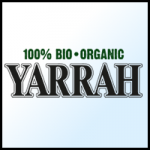 Yes, organic pet food is better than conventional pet food because what it does NOT have. A dog in general is not very picky when it comes to food. If the food smells good, the dog will eat it. There is a reason that most if not all dogs will always eat (high end) conventional food, the added chemical scents or fragrances that are applied ensure this.
Yes, organic pet food is better than conventional pet food because what it does NOT have. A dog in general is not very picky when it comes to food. If the food smells good, the dog will eat it. There is a reason that most if not all dogs will always eat (high end) conventional food, the added chemical scents or fragrances that are applied ensure this.
The second reason that organic is better is the lack of preservatives. Conventional dog food is preserved with chemical preservatives to give the food a longer sell by date. Organic pet food has a short shelf life because no chemical preservatives are applied. Natural/organic antioxidants such as rosemary extracts are used instead.Are these chemical fragrances and preservatives really healthy for dogs? Probably not. Can these chemicals cause irritations in dogs? Maybe, but why risk it when they can be avoided.
Arguing that the organic grain and meat ingredients being better than conventional can be controversial. There are many studies that prove organic agriculture produces higher quality, more nutritious products, but there are also studies that claim there are no differences. What organic pet food CAN guarantee is that there are no chemical pesticide residues, genetically modified organisms or pharmaceutical residues in the food.
Organic pet food, at least in Yarrah’s case, also guarantees that we do not use bones, feathers, hooves, blood or other cheap fillers in our products.
Does organic food improve animal welfare for farm animals and wild animals (too)?
Organic farm animals are treated much better than animals in the conventional farming industry. An organic chicken for instance lives twice as long and has over 16 times more space to live on and is able to go outside. The beef Yarrah uses, are completely grass-fed so no tropical forest have to be cut to grow soy. Organic farmers do not use dangerous pesticides, so also small rodents and useful insects like bees are not harmed.
 What changes would Yarrah like to see in the pet food industry? Where would you like pet food to be in 100 years?
What changes would Yarrah like to see in the pet food industry? Where would you like pet food to be in 100 years?
 The first thing other pet food producers should stop doing, is testing their food on animals in kennels. A dogs life should not be used in this way; it has a right to have a normal life among people in a family.
The first thing other pet food producers should stop doing, is testing their food on animals in kennels. A dogs life should not be used in this way; it has a right to have a normal life among people in a family.
The next step should be informing the customer truthfully about their products and where the ingredients come from. It is a terrible idea that people do not know that they are feeding their pets with meat of animals that are kept in small cages, with no room to live.
In 100 years, but hopefully much sooner, all pet owners will get the message that harming one animal to feed another is not acceptable. They will demand to know what is in their pet food, they will realize that chemical flavors, fragrances and colors are not needed, and will pick their brand of pet food purely on quality standards and not the amount of marketing budget a brand has available.
An Interview with The Fox Project
The Fox Project is a wildlife hospital, information bureau and humane deterrence consultancy, all specializing in the Red Fox.
 What does The Fox Project have planned for 2013?
What does The Fox Project have planned for 2013?
Pretty much going on as we are. Last year, we moved into a new wildlife hospital, which took everything up a notch. It would be nice if we could have a quiet year – time and space to settle in.
 No! Last year we admitted 640 casualty foxes and THAT was a quiet year, possibly because the fox population fell slightly – a natural phenomena with self-regulating species like the fox. But we normally take in around 750 per year and I expect 2013 will be typical.
No! Last year we admitted 640 casualty foxes and THAT was a quiet year, possibly because the fox population fell slightly – a natural phenomena with self-regulating species like the fox. But we normally take in around 750 per year and I expect 2013 will be typical.
Is the new wildlife hospital making a difference to what you can do?
 Yes. The Fox Project has struggled for 20 years with converted premises, spending valuable funds on annual renovations just to stand still. We’ve always prided ourselves on hygiene and efficiency but it’s so much easier when everything is new and designed for the purpose.
Yes. The Fox Project has struggled for 20 years with converted premises, spending valuable funds on annual renovations just to stand still. We’ve always prided ourselves on hygiene and efficiency but it’s so much easier when everything is new and designed for the purpose.
I suppose spring, when the cubs are born, is your busiest period?
We usually receive around 250 cubs along with all the adult foxes. Vixens are only in season for three days a year, all around the same time. Because of that concentration, half the year’s patient intake arrives in one quarter of the year! The majority are rescued by our three wildlife ambulance drivers and 40 local volunteer rescuers. Others come from RSPCA and organizations outside our area that don’t have suitable facilities.
usually receive around 250 cubs along with all the adult foxes. Vixens are only in season for three days a year, all around the same time. Because of that concentration, half the year’s patient intake arrives in one quarter of the year! The majority are rescued by our three wildlife ambulance drivers and 40 local volunteer rescuers. Others come from RSPCA and organizations outside our area that don’t have suitable facilities.
What happens with the cubs? How do you get them back to the wild when they’ve become accustomed to humans?
 Even those brought up on the bottle usually revert to wild by the time they’re twelve weeks old. Humans are useful in that they bring food and water and change the sawdust but that’s their only real purpose! But of course, we have a well-regulated program to prevent and undo bonding between cubs and humans. We must have this, or they could go back to the wild trusting people and that’s not in their best interest.
Even those brought up on the bottle usually revert to wild by the time they’re twelve weeks old. Humans are useful in that they bring food and water and change the sawdust but that’s their only real purpose! But of course, we have a well-regulated program to prevent and undo bonding between cubs and humans. We must have this, or they could go back to the wild trusting people and that’s not in their best interest.
 How do you feel about the adverse publicity some newspapers give to foxes?
How do you feel about the adverse publicity some newspapers give to foxes?
Without wanting to sound like a conspiracy theorist, some of those papers  have a pro-hunting agenda and support repeal of the Hunting Act. We always do what we can try to investigate stories about foxes attacking people and no case thus far stands up to scrutiny. There’s usually a hidden agenda, like wanting the local authority to remove foxes from someone’s property – which, as foxes are not classified as ‘vermin’, councils are not legally obliged to do. Sometimes it’s an attempt to divert attention from an attack on a child by the family’s own pet and to avoid the media shame that would inevitably follow. But the most common fears are based on simple misunderstandings.
have a pro-hunting agenda and support repeal of the Hunting Act. We always do what we can try to investigate stories about foxes attacking people and no case thus far stands up to scrutiny. There’s usually a hidden agenda, like wanting the local authority to remove foxes from someone’s property – which, as foxes are not classified as ‘vermin’, councils are not legally obliged to do. Sometimes it’s an attempt to divert attention from an attack on a child by the family’s own pet and to avoid the media shame that would inevitably follow. But the most common fears are based on simple misunderstandings.
 How do you combat that misunderstanding?
How do you combat that misunderstanding?
Ye ars before we opened a wildlife hospital The Fox Project was a fox information bureau. It still is, and an important aspect of that is to make knowledge of the species readily available. Like so much in life, it’s an ongoing battle of truth and reality v. myth and prejudice.
ars before we opened a wildlife hospital The Fox Project was a fox information bureau. It still is, and an important aspect of that is to make knowledge of the species readily available. Like so much in life, it’s an ongoing battle of truth and reality v. myth and prejudice.
 It’s an admirable survivor, intelligent, resourceful, adaptable, humorous, good natured and beautiful – traits we might admire in the best of people. It has suffered too long from ignorance and superstition. We owe it.
It’s an admirable survivor, intelligent, resourceful, adaptable, humorous, good natured and beautiful – traits we might admire in the best of people. It has suffered too long from ignorance and superstition. We owe it.
[print_gllr id=780]
Ethical Pet of the Month – Feb 2013
Bear and Flo
Ethical Pets of the Month, February 2013
A Few words from Jojo, Flo and Bears guardian.
My daughter and I re-homed Bear after he had 3 previous owners during the first 11 months of his life – he had been returned to the the original breeders and then been bought ‘on impulse’. He was there for 2 weeks before this owner put him up to be re-homed again. He was a nervous little fella, although bonded with my daughter and myself immediately. He showed signs of being afraid of men, and was fiercely protective of us, so we took him for a few sessions with an amazing dog communicator and healer called Julia Meads, who worked wonders – Bear and I both literally floated out of those sessions!
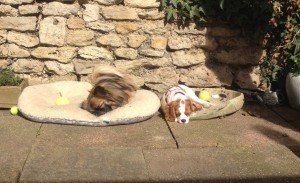
We re-homed Flo when she was 14 weeks old from a really lovely family. They were finding having a puppy around quite stressful following a family bereavement – it was a hard decision for them to make, but at the end of the day they simply wanted her to go to a loving home who could provide her with everything she needed. She adores Bear and they are always together.
Bear will be 3 years old in April and is a big ‘toy and cuddles’ fan. They are best of friends: for example, if you throw a toy for them both, Flo will always get there first but she will always let Bear pick it up! He will return his favourite toy, a soft squeaky bagel (slightly random dog toy, I have to say!), and prod you with it to encourage you to throw it again. He is ‘fluff on a stick’ and has to be groomed constantly which he adores… he only has to spot his brush and he’s on his back! He gets a lot of attention on our walks, children have asked “is he a cat?” and “is he a lion?”!
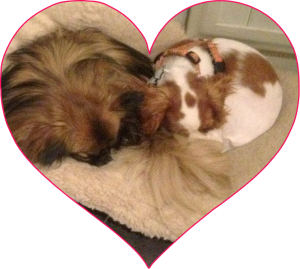 Flo is now 14 months old and LOVES LIFE! She is full of energy, LOVES her food, she ‘sings’ when excited: she is inquisitive, clever and funny. She will happily sit and watch the television, especially if there are animals on the screen. Her party piece is her ‘commando crawl’ across the floor, always first thing in the morning. She’s a bit of a tease too and often wafts her bum around Bear’s face to get his attention – she has even been seen to do it to our cat, Blackie. She has very long legs, she’s often referred to as Tigger because she bounces up and down – especially when I’m serving up her dinner!
Flo is now 14 months old and LOVES LIFE! She is full of energy, LOVES her food, she ‘sings’ when excited: she is inquisitive, clever and funny. She will happily sit and watch the television, especially if there are animals on the screen. Her party piece is her ‘commando crawl’ across the floor, always first thing in the morning. She’s a bit of a tease too and often wafts her bum around Bear’s face to get his attention – she has even been seen to do it to our cat, Blackie. She has very long legs, she’s often referred to as Tigger because she bounces up and down – especially when I’m serving up her dinner!
Flo and Bear are just so much fun, so loving… simply perfect companions. They encourage me to get out and about, as they are walked 3 time a day, and we have made some lovely friends this way. They make my day, EVERY day.
Jojo on the Ethical Pets products:
Every day they have a Vegan Mini Toothbrush on return from their morning walk, helping to keep their nashers clean, the cat usually appears at this point too! We have also tried them both on a couple of types of vegan wet food, after attending one of Anna’s inspirational talks on Vegan pets, and seeking her personal advice as they are both pretty sensitive when it comes to what I feed them. The vegan wet food wasn’t 100% successful, a few upset-tummies etc, but the Benevo Vegan Small Dog Dried Food is going okay so far! Also, we love the Wild Olive Tea-Tree Soap Bars – I have had to wash them twice this weekend due to the snow melting – I have never seen them so dirty – but now they both smell divine and their fur feels amazing! It’s much better than the shampoos and conditioners we used to get from the local pet shop 🙂
JoJo x
About JoJo
JoJo, and her daughter Amber Lily, have lived in Abingdon, Oxfordshire for 2 years. She yearned to live in a rural environment, closer to her family and somewhere for Amber Lily to grow up within a friendly, safe community. Jojo works from home as a freelance graphic designer. Once fully installed in the countryside, she seized the opportunity to get a couple of new additions to he family – and now enjoys beautiful river-side and county walks with Amber Lily, Bear and Flo. The dogs are also a big fan of Jojo’s partner John, who they see as their “big play thing!”
